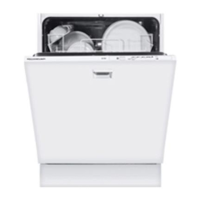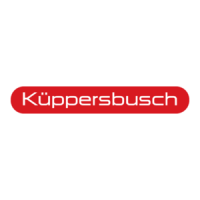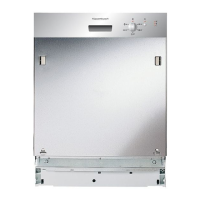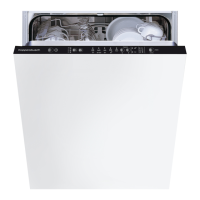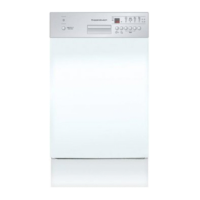Do you have a question about the Kuppersbusch IGV 6506.1 and is the answer not in the manual?
Details on connecting the appliance's water inlet and discharge hoses, including maximum permissible heights.
Guidelines for safely connecting the dishwasher to the mains power supply, including earthing requirements and extension cable information.
Guide on how to select and store settings such as program selection and water hardness on models with a display.
Instructions for adjusting settings like program, water hardness, rinse aid, and intensive drying on models without a display.
Procedures for setting options such as program selection, water hardness, rinse aid, and intensive drying for fully integrated models.
Guide to selecting and adjusting various settings for appliances equipped with a zeolite drying system, including language and auto power off.
Detailed explanation of the zeolite drying system, its components, and its overall structure.
Description of the components making up the zeolite container, including the lid, screens, and granulate material.
Diagram and explanation of the complete zeolite system structure, showing connections and components.
Explanation of the cleaning phase, where zeolite is heated to release stored moisture and prepare for absorption.
Description of the drying phase where zeolite absorbs moisture, releasing energy that heats the air for drying dishes.
Details on the electrical connections for the zeolite auxiliary heater and its control module.
Guidance on diagnosing and testing the zeolite auxiliary heater, including resistance measurements.
Step-by-step instructions for removing and installing the fan motor associated with the zeolite auxiliary heater.
Procedures for safely removing and installing the zeolite container, including electrical disconnections and securing notes.
Steps for removing and replacing the zeolite auxiliary module, requiring base panel and sheet removal.
Introduction to the power module, emphasizing electrostatic precautions and listing its connections.
Instructions for safely removing the power module, involving disconnecting leads and releasing catches.
Procedures and prerequisites for opening the rinsing cavity to access various components for replacement.
Detailed steps for carefully opening and laying down the rinsing cavity, listing components accessible for replacement.
Explanation of the safety system's role in preventing over-filling and its components like the base pan safety switch.
Description of the aquastop valve as an electromechanical safety valve that stops water flow in case of leaks.
Explanation of how the aquastop valve operates, triggered by a styrofoam float activating a microswitch.
Procedure for electrically checking the aquastop valve, including resistance measurement and technical data.
Details of the float system, which uses a styrofoam disc to activate a safety switch when water enters the base pan.
Overview of the detergent and rinse aid dispensing device, its components, and how it operates during rinsing stages.
Information on the flow sensor (impeller meter) used to measure water intake volume.
Details about the water softening equipment (ion exchanger), its function, capacity, and components.
Explanation of the water diverter's function in controlling water flow to different spray levels.
Details about the heat exchanger, its purpose in water intake and draining, and its components.
Description of the water discharge process, including the pump, hose, and non-return valve.
Lists electrical errors, their causes, and rectifying actions for issues like piezo electronics failure or residual current trips.
Lists mechanical errors, their causes, and rectifying actions for issues like basket falling or door not closing.
Introduction to error codes, customer settings, and special program access.
Details the structure of the customer service program, including preparation, checks, and measurements.
A chart detailing error groups, customer-facing displays, appliance behavior, and internal checks and measures.
A comprehensive list of error codes, their causes, and corresponding rectifying errors or actions.
Guidelines for checking water hardness when error messages appear, including active softening equipment checks.
Details on connecting the appliance's water inlet and discharge hoses, including maximum permissible heights.
Guidelines for safely connecting the dishwasher to the mains power supply, including earthing requirements and extension cable information.
Guide on how to select and store settings such as program selection and water hardness on models with a display.
Instructions for adjusting settings like program, water hardness, rinse aid, and intensive drying on models without a display.
Procedures for setting options such as program selection, water hardness, rinse aid, and intensive drying for fully integrated models.
Guide to selecting and adjusting various settings for appliances equipped with a zeolite drying system, including language and auto power off.
Detailed explanation of the zeolite drying system, its components, and its overall structure.
Description of the components making up the zeolite container, including the lid, screens, and granulate material.
Diagram and explanation of the complete zeolite system structure, showing connections and components.
Explanation of the cleaning phase, where zeolite is heated to release stored moisture and prepare for absorption.
Description of the drying phase where zeolite absorbs moisture, releasing energy that heats the air for drying dishes.
Details on the electrical connections for the zeolite auxiliary heater and its control module.
Guidance on diagnosing and testing the zeolite auxiliary heater, including resistance measurements.
Step-by-step instructions for removing and installing the fan motor associated with the zeolite auxiliary heater.
Procedures for safely removing and installing the zeolite container, including electrical disconnections and securing notes.
Steps for removing and replacing the zeolite auxiliary module, requiring base panel and sheet removal.
Introduction to the power module, emphasizing electrostatic precautions and listing its connections.
Instructions for safely removing the power module, involving disconnecting leads and releasing catches.
Procedures and prerequisites for opening the rinsing cavity to access various components for replacement.
Detailed steps for carefully opening and laying down the rinsing cavity, listing components accessible for replacement.
Explanation of the safety system's role in preventing over-filling and its components like the base pan safety switch.
Description of the aquastop valve as an electromechanical safety valve that stops water flow in case of leaks.
Explanation of how the aquastop valve operates, triggered by a styrofoam float activating a microswitch.
Procedure for electrically checking the aquastop valve, including resistance measurement and technical data.
Details of the float system, which uses a styrofoam disc to activate a safety switch when water enters the base pan.
Overview of the detergent and rinse aid dispensing device, its components, and how it operates during rinsing stages.
Information on the flow sensor (impeller meter) used to measure water intake volume.
Details about the water softening equipment (ion exchanger), its function, capacity, and components.
Explanation of the water diverter's function in controlling water flow to different spray levels.
Details about the heat exchanger, its purpose in water intake and draining, and its components.
Description of the water discharge process, including the pump, hose, and non-return valve.
Lists electrical errors, their causes, and rectifying actions for issues like piezo electronics failure or residual current trips.
Lists mechanical errors, their causes, and rectifying actions for issues like basket falling or door not closing.
Introduction to error codes, customer settings, and special program access.
Details the structure of the customer service program, including preparation, checks, and measurements.
A chart detailing error groups, customer-facing displays, appliance behavior, and internal checks and measures.
A comprehensive list of error codes, their causes, and corresponding rectifying errors or actions.
Guidelines for checking water hardness when error messages appear, including active softening equipment checks.
| Brand | Kuppersbusch |
|---|---|
| Model | IGV 6506.1 |
| Category | Dishwasher |
| Language | English |
